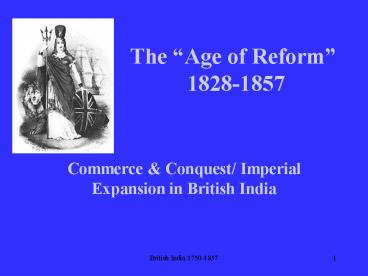The - PowerPoint PPT Presentation
Title:
The
Description:
The Age of Reform 1828-1857 Commerce & Conquest/ Imperial Expansion in British India 1828 has traditionally been regarded as demarcating the beginning of a new ... – PowerPoint PPT presentation
Number of Views:63
Avg rating:3.0/5.0
Title: The
1
The Age of Reform 1828-1857
- Commerce Conquest/ Imperial Expansion in
British India
2
- 1828 has traditionally been regarded as
demarcating the beginning of a new era in the
history of British India. - Up to this time attitudes concerning the
governance of an alien society varied and were
mostly discordant. - But the dominant ethos was ' reformist' and it
grew in strength and stridency. - Initially held at bay, it captured the mind of
Parliament first, indoctrinated the bureaucratic
class that was trained at Haileybury to run the
new empire, and overwhelmed the objections of
orientalists and pragmatists
Stacking opium ballsFrom The Graphic 1882
3
- By 1828 liberals like Macauley and Utilitarians
like Mill, Bentinck and Trevelyan had the field
to themselves and immediately instituted
reformist programmes. - Lets examine those programmes, evaluate the
impulses and motives that informed them, and
measure their impact on Indian society. - Whether the changes foreshadowed or legislated
for between 1828-56 deserve to entitle this 30
year period as 'The Age of Reform', however,
remains a moot point
4
- Up to 1828 we have the development of a reforming
ethos - After 1828 we reputedly have application of a
reforming program. - This reforming program had at its heart the
Doctrine of Improvement. - India seen as a 'laboratory of experiment' in
social and political engineering.
5
But improvement of what kind?
- Improvement could take different forms and
reflect different inputs. - To liberals improvement Western education
- To utilitarian improvement good laws
- To evangelicals improvement Christianity and
conversion
6
- In historiography the period 1828-1856 has been
labelled 'The Age of Reform' - Is this merited? If not, why not?
- Possible explanation Age of Reform is a concept
needed to explain the Mutiny which followed it?
Thus British meddling/interference provides an
ideal backdrop for Indian reaction and resistance
in 1856-8.
7
Opposing historical explanations
- But J. Nehru disputes the point that the British
were reforming zealots, who went too far too
quickly, in a 'cultural blitzkrieg'. Instead, he
argues, the British remained, from first to last,
lily-hearted bureaucrats - who contemplated
change only if it were safe. - V.G Kiernan 'The Lords of Human Kind' draws our
attention not to what the British actually did,
but to how they did it. That is, it was not
British reforms that were the problem so much as
British methods.
8
The Coming of Bentinck
- Gov.-General 1828-1835
- What sort of man was he?
- Relied on advice from strong-willed advisers.
- Therefore susceptibility to instigate change in
line with current reformist views. - His "Reforms" fall into 3 categories
- 1. Social Do they amount to much? Negative in
character - 2. Legal Macaulay's New Legal Code 1834 (Mill's
influence) Western, uniform, far-reaching. - 3. Educative Macaulay's Reform Minute of 1835
considered the Key Measure of this period.
9
Educative measures
- 1835 Education Minute Features 'Filtration'
theory Education filters down from elite to
masses Brown Englishmen created - - Motivations
- - Racial - administrative - commercial
- Results - (1) An unexpected Growth of
nationalist sentiment - - - (2) An unexpected development of
Hindu/Muslim rivalry
10
Dalhousie 1852-1856
- Dalhousie and Economic 'Improvement'
- - Infrastructure of modern state put in place
- (a) railways (b) telegraph (c) universities
- - Emphasis on both shovel and pen
- Dalhousie Gov.General 1852-56 an
interventionist - Able to execute utilitarian policy not simply
make policy statements. - Conclusion Do the above 'Reforms' constitute a
full-scale-assault on Indian Custom? If not, how
do we explain the Mutiny?
11
Blog Questions
- 1. What did Utilitarianism, as outlined by James
Mill and applied by its apologists for
generations, consist of in the Indian context? - 2. T. B. Macauley's Minute of Education (1838) is
always depicted as the centrepiece of British
'reformism'. Why was it important? - 3. In what ways was Dalhousie's approach to the
improvement of Indian society different from
either Mill's or Macauley's?
12
Articles
- K.A. Ballhatchet, 'The Home Government and
British Educational Policy', Cambridge Historical
Journal, 10, 1951 - Special Issue of Indo-British Review 'The East
India Company Raj', Vol. XXI, no. 2 (1996) - G.D. Bearce, 'Lord William Bentinck The
Application of Liberalism to India', Journal of
Modern History. 28, 1956 - S. Gopal, 'Dalhousie', History Today, 9, 1959
- G N Sirkin, 'Battle of Indian Education
Macaulay's Opening Salvo Newly Discovered',
Victorian Studies, 14, 1971 - E. Stokes, 'Macaulay the Indian Years 1834-38',
Review of English Literature, 1, 1960































